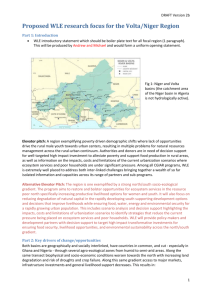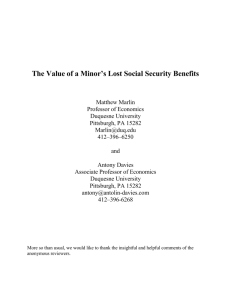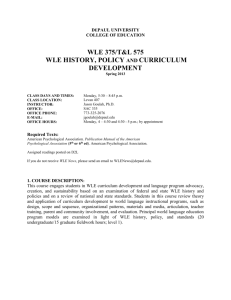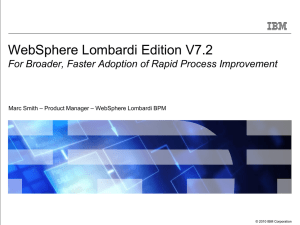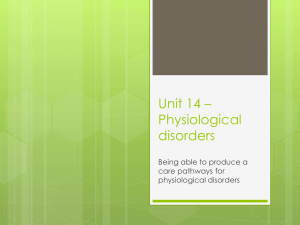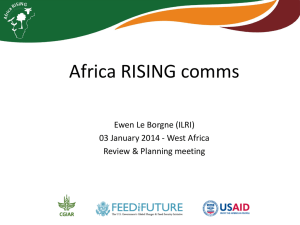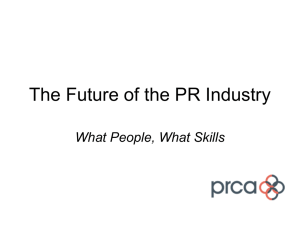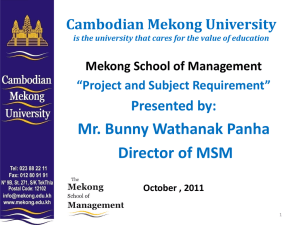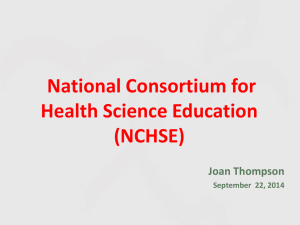WLE-Impact_pathway_present
advertisement
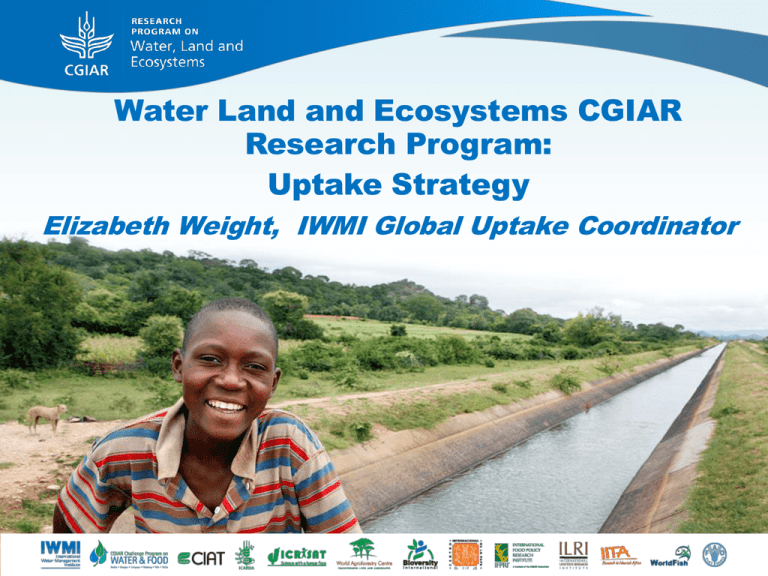
Water Land and Ecosystems CGIAR Research Program: Uptake Strategy Elizabeth Weight, IWMI Global Uptake Coordinator Contents • Overview of WLE at a Glance • Overview of WLE Impact Pathways and Impact Pathway thinking • Fitting in Comms/KM into impact pathways • Assignment WLE Goal: Sustainable intensification of agricultural development WLE Uptake Framework: CGIAR SLOs and WLE IDOs CGIAR System Level Outcomes 1. Reduce rural poverty 2. Increase food security 3. Improve nutrition and human health 4. Sustainable management of natural resources WLE IDO: Risk WLE IDO: Gender WLE IDO: Productivity WLE IDO: Income WLE IDO: Equity Management Women and Increased and marginalized more equitable Improved land, water and energy Increased resilience of income from agricultural and groups have decision making Increased ability of low income productivity in rainfed and communities through enhanced natural resources power overagro-ecosystems and management increased communities to adaptinto irrigated ecosystem services and ecosystem services in rural benefits derived from environmental and economic agricultural landscapes. and peri-urban areas shifts, agriculture and natural variability, demographic resources. shocks and long term changes WLE Future Impact Pathways Flagship Thematic Impact Pathways Focal Region Development Challenges with integrated work from different SRPs RRR Salinity Landscape degradation Information Decisionmaking Mekong Indus/Ganges Nile-East Africa West Africa WLE Current Reality • More than 160 projects, mapped into SRPs and aligned to activity clusters • No coordinated work in the Basins WLE Uptake Framework: CGIAR/ISPC Impact Pathways/Theories of Change System Level Outcomes WLE research outcomes WLE Intermediate Development Outcomes WLE research outputs WLE uptake strategy: significant focus on the research client WLE research outcomes Opportunity identification Levers and incentives Partner engagement System Level Outcomes WLE research outputs Client analysis Decision analysis WLE Intermediate Development Outcomes Example of client focus: WLE resource recovery and reuse Issue: Urban areas are growing and consuming more resources. How do we recover nutrients and water at scale? Technical knowledge is available, but few projects go to scale. WLE seeks to change this by analyzing business models and returns on investment. Clear client focus: the private sector, public private partnerships, and business schools The research portfolio is designed for the client: analyze successes and test promising business models for replication at scale Multi-disciplinary research team includes economists, business developers, and environmental scientists Faecal sludge Nutrients for agricultural production Supporting research client decision making through decision analysis WLE research outcomes Opportunity identification Levers and incentives Partner engagement System Level Outcomes WLE research outputs Client analysis Decision analysis WLE Intermediate Development Outcomes Example: the decision analysis process Northeast Kenya: Tap the Merti aquifer to pump water > 100 km to town of Waiir? Identify risks and uncertainties in decision of interest Engage decision makers Compute value of additional information (uncertain variables with high information value = priorities for measurement) Applied Information Economics D. Hubbard, “How to Measure Anything”, 2010 Make probabilistic cost/benefit impacts on different stakeholder groups of likely outcomes of decision Probabilistic outcomes (benefits/negative impacts) for different stakeholder groups Focused partner engagement, levers and incentives WLE research outcomes Opportunity identification Levers and incentives Partner engagement System Level Outcomes WLE research outputs Decision analysis Client analysis WLE Intermediate Development Outcomes Changing how decisions are use of dams in the Mekong are made CPWF Mekong use of communication and knowledge management to improve dialogue 1. Mekong Forum to dialogue around research 2. Short targeted State of Knowledge studies– in all Mekong Languages 3. Use of Film and video 4. Study tours and exchanges 5. Face-to-face individual discussions with Chinese Dam operators, investors, policy makers Convening Power and Trust Changes in how some dam operators carry out relocation and livelihood schemes, manage flows Can discuss issues without fear of getting “shut down” Designing Impact Pathways Design Impact pathway Revise assumptions Identify new opps Identify changes Research Engagement Client Analysis Network Mapping Assessing entry points Develop Outcome Logic Model Reflect Implement Develop Implementation Plan Change agents, assumptions, strategies, Budget Resources Capacity Comms/KM Types of KM Activities Support Learning Culture Comms for development Open access of materials Comms for policy influence Communicatio n about the project Repackaging, co-creation Sharing and discussing progress Adapted from Simone Staiger Integrating Communication & KM Impacts Outcomes Outputs Activities Research KM on processes Comms on what the project does Engagement Internal Implementers Products into use Repositories Repackaging Communicate about results Partners Comms/KM Processes Engagement Meetings Advocacy Users External Different approaches for different groups. One-way communication - the complexity of the issue is low, the message; high certainty Two-way communication - the issue is complex, the message difficult, no immediate guarantee Participatory approaches - issue is highly complex, the messages not clear yet and there is yet no certainty that the action will lead to the desired outcome Do we communicate to the right audience capable of taking the action we desire? • Context matters – what are barriers? • Who are the messengers (Not just products) • How will products support impact pathways. Assignment • WE will take 4 draft impact pathways and transform them into Outcome Logic Models and then develop a KM/Comms plan for them – – – – Global Regional – Volta Thematic – Landscape Degradation Thematic – Information Decision-making • 1hr developing outcome logic model • 1hr developing draft plan for KM/Comms plan
